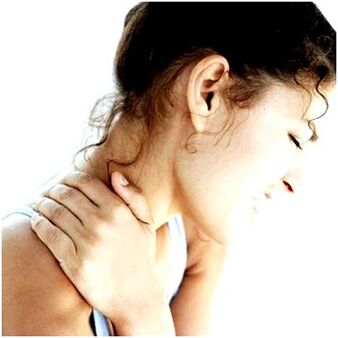
Osteochondrous process has more than one effect on the spine or several times.Lomber and cervical vertebrae are most affected by the most sensitive pathologies that are loaded due to the anatomy of the human skeleton.
The results of the spinal osteocondrosis in the cervical region are the most concern and potential complications, because the neck is a rich area on neuromzivivive highways, which nourishes the brain.
For this reason, clinical symptoms with cervical osteocondrosis are many of the brain regions related to iSchemia.In addition, the sensitivity of the destroyed vertebrates can give the sensitivity of the hands and shoulder zone and the nervous roots that provide motor activities can give a variety of symptomatic pictures.
Below, consider the general clinic of the osteocondrosis of cervical spine.
Dizziness
The dizziness is also due to the violation of blood flow to the bodies of the inner ear, which ensures the balance of the body.Nystagm often joins the dizziness - the students in the eyes join the arbitrary fluctuations on the side.
Weatherlessness
This sensation appears due to the irritation of the tips of the diaphragmatic nerve.This is part of the cervical nerve beam and participates in the regulation of breathing, depth and frequency.Patients complain about failure to breathe with full chest.
In some cases, the symptom increases severe breathing and suffocation.For the same reason, breathing stops at night and neurect.
Due to breathing problems, the lack of oxygen is the result of increasing fatigue, the cause of the decline in concentration and memory problems.
Nausea
Gelching is accompanied by air.Due to blood circulation problems in some areas of brain and inner ears.Nausea is sometimes observed with a delay vomiting, which is provoked by the actions of the head and body.Often the result of nausea and vomiting is the reduction in appetite, weight loss, aliminalization.
Problems with vision
"Flying" in the eyes, reducing visual acute, fog in front of the eyes - these are signs due to the ischemia of the territory of the brain.
Patients with osteocondrosis complain less vision, because the lack of blood supply from spine is compensated by blood flow from the carbon artery system.
Glasses and therapeutic gymnastics for eye muscles do not solve the problem, it is usually improved after the treatment of osteocondrosis.
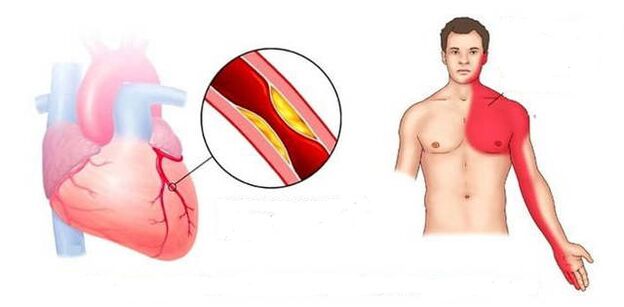
An unstable pressure level is due to blood flow in the bent brain, which is responsible for the functions of the vascular motor center.
Due to the short-term stopping of blood flow throughout the vertebral arteries, it occurs with a spasm of the brain vessels.
From the loss of a loss of the patient's consciousness, the legs can be removed quickly - the blood flow to the brain allows a person to carry out.
After a war of blood flow, the problems and actions of blood flow can be observed for a while.
Green symptoms
It can often be the only hint showing cervical osteoocondrosis.It is expressed in the throat, a piece, dryness and feeling, as a difficulty of absorption.Symptoms are associated with the compression of the nerve plexus, which is in charge of the Farenx Innervation.Such manifestations need to distinguish from a similar clinic for inflammation or neoplasms.
The growth of body temperature for cervical osteochondrosis is not the most typical symptom, rarely and locally observed: with skin light daughter in cervical and collar.
The cervical spine can be osteocondrosis clinic, which is in a variety of extent, which is brighter, the second depends on the development stage of pathology that occurred on certain syndromes.
Stage i
The beginning of degenerative processes in the cartilage of vertebral discs.Symptoms are weak, sometimes it cannot be observed at all.The first signs of the osteocondrosis of cervical spine:
- Concern in the neck, arms, shoulders, sometimes turns into pain;
- headache;
- Easy restriction of neck car activity;
- to quickly pass through visual impairment;
- Reduce the sensitivity of the collar area of the collar.
Important: These symptoms are more pronounced when bending the head.
As a rule, in the first stage of the osteocondrosis of the cervical region, patients do not go to the doctor, believing that all symptoms are related to fatigue, stress, age, lack of sleep.
Stage II
At this stage, the protrusions of the vertebrates began, intervertebral cracks were narrowed, the collagen fiber of the libergent ring is destroyed.Due to the congestion of the result, there are symptoms of a point in strengthening the nature, neck and head loops during the movements of the heads of the head.You can already suspect the cervical osteoocondrosis here, in the second stage, the symptoms are as follows:
- Pain in the neck, sometimes with a crisis;
- The sensitivity of the shoulders and hands loses almost completely;
- Headache is often, do not pass long time;
- visual impairment with "flies" in the eyes;
- noise and noise in the ears;
- weakness of the muscles of the upper extremities;
- The clarity of tendon reflexes decreases;
- Pain in pain with dedication under the shoulder blade;
- a piece of fabric in the throat, swallowing problems;
- Sleep disorders are usually insomnia.
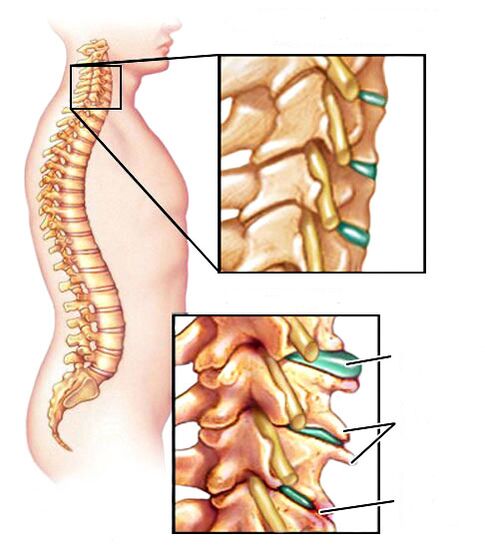
Holding the head in one position, causing severe pain for a long time.At this stage of the development of the disease, patients have already arrived at a doctor for help.
Stage III
The fibrous ring on the disk is destroyed, the corners occur.In the third stage, due to weak fixation, there is deformation of spine, displacement and displacement of spines due to weak fixation.Symptoms are:
- Intensive, sharp pain in the neck, collar zone, heart region;
- Sensitivity of the scalp behind the head, in the shoulder area, in the hands, complete absence;
- torns of cervical spine;
- Paraphise and paralysis of upper extremities;
- Tender reflexes are not practical.
This is a severe stage of the disease that the patient could not support his head.The compression of spinal cord ischemia and spinal arteries causes paralyzes and paraphity in the body and spinal kick.
A large number of various symptoms accompanying the osteocondrosis of cervical spine and make a large number of various symptoms, because some may be a sign of completely different diseases.The symptoms of cervical osteochboard are formed in certain groups called syndromes.Their presence and severity can show a pathology in cervical spine with updated localization.
Clinical view of the osteocondrosis of cervical spine - Symptoms, signs
Osteocondrosis of the cervical region, Oneurebrae, intervertebral compounds and discs are affected and destroyed and destroyed, slowly progressive spinal disorders.Vertebra from the first to the seventh belonging to the cervical region.
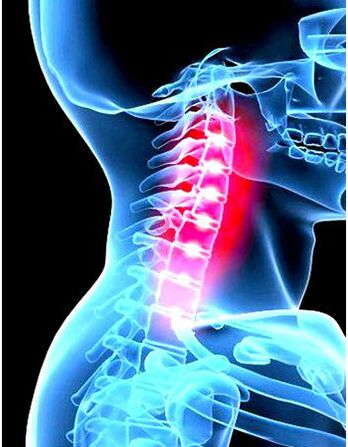
As the disease progresses, intervertebral disks lose their elasticity and strength, flatten, relax, and worse depreciation features.It occurs due to changes caused by deformation, electric disorders and tissue depletion.
These violations are one of the natural processes of the body, but various downloads, posture disorders, congenital Anborities and other causes of spine cause cartilage and discs early.
The pain can have different localization, in the neck, in the oxipital region, in the shoulder or upper extremity.The pain in the shoulder or hand innervates the upper part of the spine of the nerve.Pain in the occipital part of the head is caused by compression of neck muscles connected to the oxipital bone and blood circulation disorder in this area.
When symptoms occur:
- The decrease in the sensual in hand occurs when a waist is damaged, which includes sensitive nerves with innervative nerves in the upper extremity.
- During the move, the cervical spine and the limitation of the crisis are due to the higher joints of the height of the intervertebral disk, the appearance of bone growth in the body of the spine and the cervical vertebra.
- Dizziness occurs in difficult cases with a strong deterioration of impaired coordination, weakness, brain, cerebellum and high blood supply to the oxipital fraction.
- Decrease in numbness, hearing and vision of language
All these symptoms are related to the participation of vertebral artery in the process in the process of broadcasting cervical vertebrae.As a result of cervical osteocondrosis, fibrous tissue, spine of spines, blood flow in these veins deteriorate blood flow to the oxipital part of the brain and cerebellum.
Reasons
- Excessive physical activity in sport or severe physical labor;
- hereditary tendency;
- Neck hypothermia (walk in the winter without a scarf);
- Stress;
- work on the computer;
- the obesity.
Some of the above lead to osteocondrosis and other spines.
The rate of osteocondrosis is determined by the patient's clinical view and complaints.The concept of the lesson should not be confused with the stages of osteocondrosis.Stages will be discussed below.
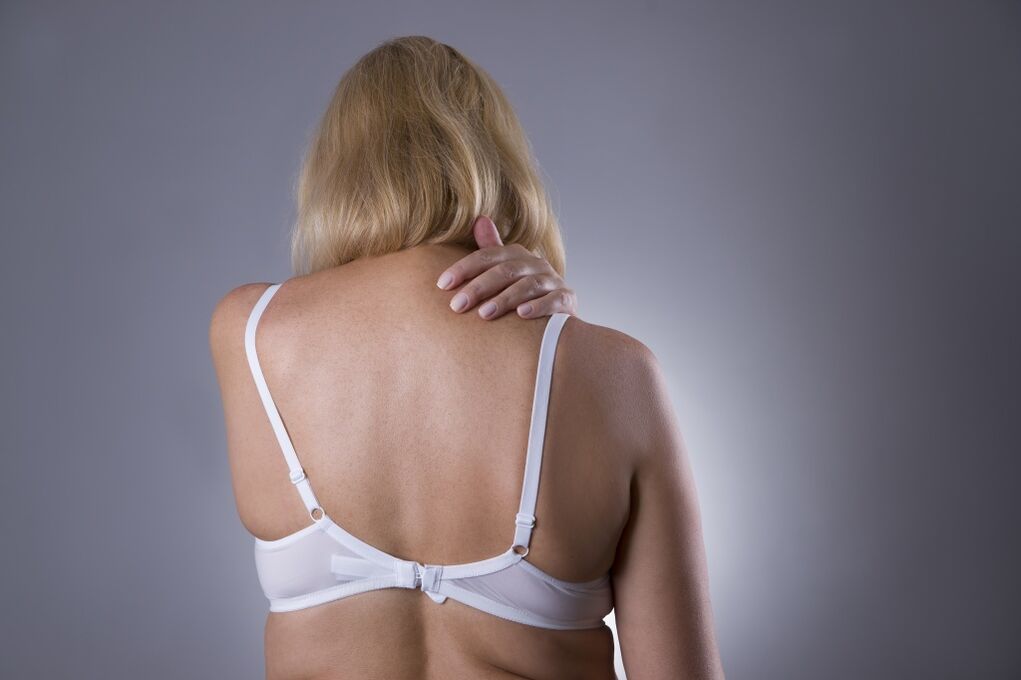
Given the development procedure for the development of changes in the tissues of vertebra, doctors distinguished several stages of osteocondrosis of the cervical region:
- Preclinic phase.The 1st degree is stated by the start of the detection of the pulpoose core and the destruction of the pulpoose nucleus and the destruction of the fibrous ring.There will be no pain in this period, a small lordioosis and difficulty in the turning or bending of the head.
- Osteocondrosis of the cervical region of the 2nd degree cervical region is an increase in pathological destruction, instability and a pain in the whole segment, sometimes appears in the shoulder belt or arm.The patient complains of distractions, memory and attention.
- The 3rd grade osteocondrosis is developing with a full rim of the ring.Neurological symptoms appear, sensitivity is concerned.The pain in the third stage becomes permanent and the patient is very concerned.The mobility of the cervical segment is deteriorating.
- Osteocondrosis of the neck is 4 degrees.The final stage of the degenerative process.The intervertebral disk is replaced by completely connective tissue, all symptoms are more pronounced, it is deteriorating in the coordination of movements, the ataxa is noted.
Depending on the localization of the pain, the following types of diseases are different: radiculoichemia, servycolocraticocracialism and cervical.
Of course, the disease is an accustomed to dividing the acute intervert to the osteas of the neck, which is visible for the first time and chronically, continued remissions and complications.
Which doctor treats cervical osteochondrosis?
Often symptoms hidden under another disease mask, causing the logical question to patients - which doctor does?Approaching pain, neurologists or any obstacles occurs on the neck, shoulders and seizures or neurotic disorders are relevant.
Who can be applied to the local clinic if there is no such specialist?In this case, the ticket must be postponed to therapist.The doctor will appoint treatment or send a narrow qualification to the doctor.
Symptoms depending on damaged vertebrae
Separately, radicular syndromes can be different, leading to one or another sensitive and motor disorder.It differs depending on the spine striking the spinal root:
- C1: cause numbness and impaired sensitivity behind the head;
- C2: Pain in the parietal region and behind the head;
- C3: Talk impairment, language sensitivity, sensitivity of sensitivity to the part of the spinal nerve violated;
- C4: decrease in heart pain, hypokondrium, shoulder, shoulder blade, respiratory disorders, neck muscle tone;
- C5: Pain on the shoulder of the outer area;
- C6: Pain from the front shrub to the thumb of the hand, as well as the shoulder blade;
- C7: Pain on the back surface of the shoulder gives you the neck to the shoulder blade, 2-4 fingers;
- C8: Pain from neck from neck to little finger on the neck.
Diagnosis of osteocondrosis
Instrumental inspection methods are used to diagnose:
- Examination of the X-spinal department;
- Myeleography;
- Sensitivity, Neurological Study of Reflexes.
Additional methods designed to differentiate and clarify the diagnosis, the pathology includes:
- Tomography of the spine (CT);
- Nuclear magnetic resonance (Jamr);
- Magnetic Resonance Image (MRI).
During the examination of neurological tests, the doctor will assess the degree of mobility and pain in the onurbal artery.
The cervical osteochondrosis requires only the study of herself and close tissues, blood vessels, and nerves.Only then can we judge the full photo of pathological changes that occurred due to the disease.
The diagnosis of cervical osteocondrosis begins with a vision examination and the patient's investigation.The neuropathologist is interested in the patient's life and labor, chronic diseases, nutrition and motor activity.
An initial diagnosis is confirmed by instrumental research:
- In the X-two forecast;
- MinisterOpen
- CtOpen
- Express (duplex scan).
Hormones for sex sex are required.Without it, the treatment of cervical osteochondrosis in women will not begin.
This type of symptoms are a differential diagnosis of additional consultations with a surgeon, gynecologist, cardiologist, ophthalmologist and Lore to exclude pathologies.
Osteocondrosis complication
Osteocondrosis of cervical spine is dangerous with its aggravation.With negative development of the disease, squeeze the spinal artery may result in a stroke of the brain, hearing and vision.
Often an intervertebral hernia, fierce hypertension and the cooling or cooling osteocondrosis of fingers.In women, the complication of a neurological nature is often developed - sustainable fatigue, lethargy, performance loss, extreme dissatisfaction.
Defined treatment, the lack of a doctor's long-term doctor and osteocondrosis therapy contributes to the progress of the disease and leads to the development of complications, pathologies and new diseases:
- Intervertebral disks rholes (spine brown);
- the protrusion;
- Kyphetic;
- radiculitis;
- Salt deposits in intervertebral space;
- spinal cord strokes;
- Reducing muscle mass of muscle mass, muscle crop due to blood supply;
- paralysis of lower extremities.
Although the 4th rate of osteocondrosis of osteocondrosis without symptoms and pain, the indifferent osteocondrosis can be the most dangerous for the development of serious complications and the patient's disability.
Medical physics education
LFC should be carried out of acute sharpening for cervical osteocondrosis.The greatest effectiveness of this technique during the recovery period.There should be no concern and pain during the implementation of the complex!
| Workout # 1 | Put your hands on your stomach, place your hands, grow your head and torso, your back should be flat.Stay in this case for 1-2 minutes.Slowly sink the ground.Repeat 2-3 times. |
| Workout # 2 | Stretch your arms throughout your stomach, turn your arms left, turn left to the left, try to touch the ground with your ear, then turn the head to the right.Repeat 6-7 times in each direction. |
| Workout # 3 | In the seating position, lean forward, and then touch your chest with your head, turn back, back to the back and discard the back.Repeat 10-15 times. |
| Workout # 4 | Place your palms on your forehead, put pressure on your foreheads and your forehead is in your palm.Continue this exercise for 30 seconds.Repeat 2-3 times. |
| Workout # 5 | Slowly turn your head in one direction, then in the other direction.10 rotations in each direction.Make sure there are no dizziness.When it seems, the training stops. |
Risk factors
If you have a chance to grow osteocondrosis:
- abnormalities of the development of spine;
- Weight excess weight;
- long physical effort;
- bad habits (smoking);
- Seated lifestyle;
- Work (for example) of the spine (for example, the regular impact of vibrations with drivers of vehicles;
- long stress, extreme nervous tension;
- Local hypothermia;
- Injuries with neck and napeda;
- Otoimmune pathologies that cause the cartilage degeneration.
Psychosomatics
The development of cervical osteochondrosis shows you fail to endure problems.Sometimes people are confident in their ability because they are so strong and confident in their skills and become a lack of difficulty strengthening and comfort.At this situation, attempts to turn their heads are accompanied by hardness, convulsions and other unpleasant feelings.
In addition, we do not fear osteochondrosis problems and cope with them.In this case, the mammal's protective reflex is triggered and the head is drawn to the shoulders without words.This provision is considered unnatural, so it is then starting to hurt and deform the muscles of the cervical region.
Treatment
The treatment of cervical osteochboard is depends on the stage of the disease.In the first stage, a fairly conservative, walking treatment, then the doctor's task in the second and third stages, to stop pain syndrome in the first place.Developed cases, vertebrae may require surgical treatment for decompression and stabilization.
Medicine
| Group | Description |
| NSAIDS (non-relevant antiestinflamer drugs) | Help eliminate swelling and pain.The basis of the most commonly used medications are the components that act like sodium diclofenac. |
| Vasodilative drugs | Blood helps improve circulation. |
| Seditives, muscle streaks | It is assigned to facilitate the patient's general state and reduce NSAID's doses.At the same time, relax nervous overstrain and muscle cramps, help you get a better therapeutic effect. |
At the end of the course of therapy, NSAIDS must be purchased for the first set for a home, because the pain in the neck can be returned periodically (stress, overstrain, air change).Apply to your doctor before taking any medication.
If there is no positive impact after conservative treatment of a conservative treatment, the doctor may recommend the patient's spinal fuss.
This procedure allows you to immobilize the affected spinal segment.
Its essence is an intervertebral disk, decompression of the nervous root, the installation of the implant or the establishment of a physiological height of the disk area.
There are many side effects and opposite instructions of the operation.Thus, it can cause disability from the verdict.Therefore, the operation is carried out in extreme cases.
Massage with cervical osteocondrosis allows you to improve significant.The procedure is important by professional: Inexperienced actions in the cervical waist region can aggravate the situation.The actions should affect the collar zone, cervical region and rear.
Note the technique for the treatment of cervical osteochondrosama for osteochondrosia, pay attention to the alternative of the following actions.
- Stroking.The masseur affects the surface layers of the skin, moving towards the upper part of the back.At the same time, the tip of the palm or fingers works.
- To squeeze.The deep layers of the skin located in the third part of the back are exposed.In this case, the index and thumb in their hands are taken to get skin.The fabrics adjacent to Vertebra do not participate in this process.
- Trituration.It is done to warm the skin and increase blood flow in the collar area.The procedure should be performed very carefully.Vertebrae's spinous processes are prohibited to influence.Sometimes rubbed with circular strokes or movements that look like a saw.
- Kneading.Affects deep false pieces so there is a limited value.Can aggravate the Patriaway.
At the patient stomach during the massage, in extreme cases, should sit.
Prevention

Recommended for the prevention of the disease:
- Topics that have fallen into a orthopedic pillow and mattress for the health of the spine;
- Take a hot shower for 10 minutes daily;
- Visit the bath or sauna (relaxing the cramps of neck muscles);
- Avoid sharp tiles and return turns;
- Walk more infantry, yoga and swim;
- Give a five-minute break every hour with the "Sitting" case (walking during breaks, you need to walk in the body and in different directions);
- Avoid increasing loads in the spine: weights, jumps, runs;
- Choose chairs and chairs supporting the spine;
- Smoking, to leave addiction as alcohol operation;
- Drink at least one-half liter of water a day.
Eating with cervical osteocondrosis is often recommended (at least five times a day) and in small parts.Vaporized or baked dishes should be preferred.Salads should need the spice with olive oil.

























